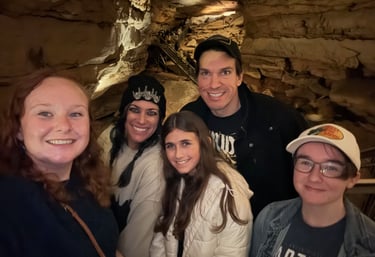Cave Week Day 2: Mammoth Cave and the Immensity Below
Day 2 of Cave and Karst Week: Welcome to Mammoth Cave—a 430-mile subterranean monster where geology went feral and microbes run the underworld. Blind creatures, ancient echoes, and deep-time chaos carved straight into stone. Go in with questions. Come out changed. Maybe.
FERAL SCIENCECAVE WEEKCAVE & KARSTMAMMOTH CAVE
6/2/20253 min read
You think you’ve seen “big”? Mammoth Cave doesn’t do “big.” It does limitless. It’s the longest cave system on the planet, and it’s not even close. As of today, over 430 miles of underground passageways have been mapped. That’s right: four hundred. thirty. miles. And every time we think we’ve hit the end, she casually opens another tunnel like, “oh, did you need more abyss?”
That’s not just a cave. That’s a subterranean continent. This place isn’t just long—it’s layered, chaotic, vertical, flooded, collapsed, and reborn again. It’s limestone architecture carved by water, time, and a total disregard for your sense of direction. You want a metaphor for resilience, mystery, and untamed geological storytelling? Mammoth Cave is the metaphor.
🧭 Why Visit? Because It’s a Gateway to the Underworld.
Mammoth Cave National Park isn’t a roadside attraction. It’s a full-blown pilgrimage for anyone who respects deep time, extreme environments, and the kind of scientific madness that lives underground. The park offers tours for every flavor of human:
The Historic Tour is perfect for wide-eyed wanderers who want to walk the same halls where Indigenous miners, enslaved explorers, and early scientists made history.
The Violet City Lantern Tour? Moody, spooky, minimal light. Maximum vibes.
The Wild Cave Tour is a controlled descent into the chaos dimension. Helmet. Elbow pads. Belly crawls. We do not recommend this if you fear the dark, enclosed spaces, or your own thoughts.
And the surface? Hiking trails, backcountry camping, river paddling, dark skies for stargazing—and a haunting silence that feels prehistoric.
🪨 What Makes It Matter?
Geologically? It’s karst perfection—Mississippian limestone, capped by sandstone, swiss-cheesed by water over eons. This is where hydrogeology goes full opera.
Biologically? Over 130 species live in and around the cave, including blind cavefish, albino crayfish, troglobitic beetles, and microbial colonies thriving in darkness. Some of these microbes are being studied for biomedical potential. Yes—cave slime may one day save your life.
Ecologically? The cave connects to the Green River system and plays a huge role in regional water dynamics and biodiversity corridors. What happens in the cave doesn’t stay in the cave—it shapes the whole landscape.
Culturally? Humans have been entering Mammoth Cave for over 5,000 years. Indigenous miners harvested gypsum. Enslaved guides like Stephen Bishop mapped the system from memory. It became a bizarre tuberculosis hospital in the 1800s (spoiler: that went badly). It’s a living record of trauma, triumph, and the kind of raw human curiosity that crawls into dark holes just to see what’s there.
Economically? It’s the heart of regional tourism, drawing in half a million people a year. That’s jobs, research dollars, small businesses, and a whole ecosystem of cave-adjacent weirdos keeping the place alive.
🤘 Weird Facts, Because You Know We’ve Got Those
There's a passage called "Fat Man’s Misery" and it’s just as judgmental as it sounds.
In the 1800s, people attended concerts in the cave, because everything sounds better when it echoes off ancient stone.
Mammoth Cave still houses graffiti from the 1800s. Bring curiosity, not Sharpies.
One section of the cave is so quiet, scientists have used it for acoustic isolation tests.
You can stand in total darkness and hear your own heartbeat echo off the walls. (This is how people unlock side quests.)
🔬 What It Means to CHAOS
Mammoth Cave is what happens when time, pressure, water, and microbes throw a 350-million-year party and forget to clean up. It’s a monument to resilience, erosion, and the feral power of geology to rewrite everything—biology, history, culture, even medicine. At the CHAOS Lab, we care deeply about caves like this. Not just because they’re cool (though… obviously), but because they’re functional testbeds for geohealth, microbial bioprospecting, and unraveling how Earth's extreme environments shape survival itself. If you’re not at least a little obsessed, we can’t help you.
🎟️ Plan your visit: https://www.nps.gov/maca
👟 Wear boots. Bring snacks. Respect the karst.


430 miles of chaos, microbes, and geological audacity.
